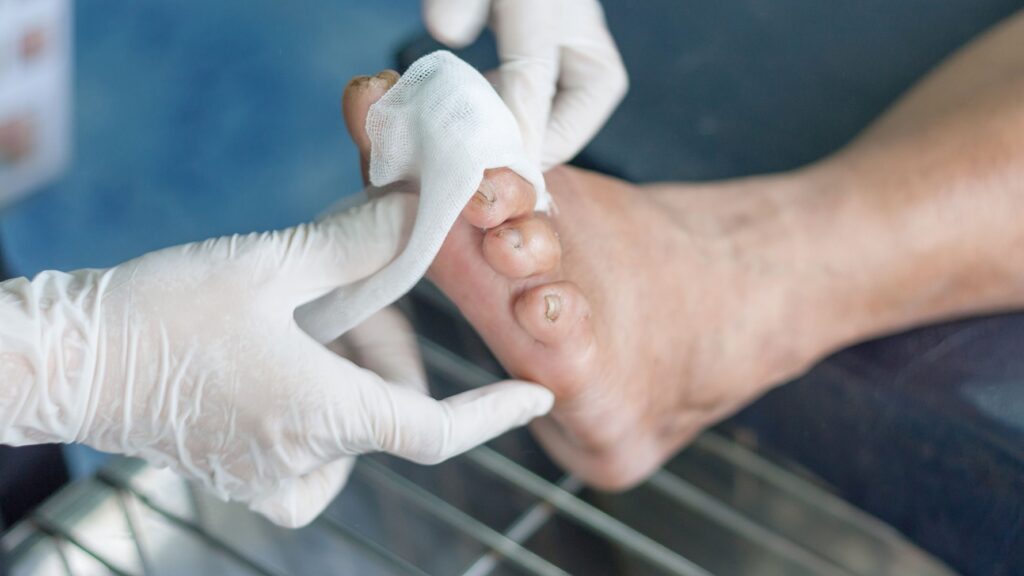Diabetic foot ulcers are a common complication of diabetes that can lead to severe health issues if not properly managed. These ulcers form due to a combination of factors including poor circulation and nerve damage. Early detection and appropriate treatments for diabetic foot ulcers are crucial in preventing further complications.
In this article, we will explore the essentials of managing diabetic foot ulcers, focusing on who would benefit from early screening and treatment, what causes these ulcers and why treatment is necessary.
Who Would Benefit from Early Diabetic Foot Screening and Treatment
Early diabetic foot screening and treatment can benefit individuals at risk of developing foot ulcers. People with the following characteristics should consider early screening:
- Long-standing Diabetes: Those who have had diabetes for several years are at a higher risk of developing foot complications.
- Poor Blood Sugar Control: Individuals with consistently high blood sugar levels are more prone to nerve damage and poor circulation.
- Previous Foot Ulcers: A history of foot ulcers increases the likelihood of recurrence.
- Peripheral Neuropathy: People experiencing numbness or tingling in their feet due to nerve damage.
- Peripheral Artery Disease (PAD): Reduced blood flow to the extremities can slow down healing and increase the risk of ulcers.
- Foot Deformities: Conditions like bunions, hammertoes, or calluses that create pressure points.
- Limited Mobility: Those with restricted movement may not notice foot injuries early.
Early screening can help identify potential issues before they become severe, allowing for timely intervention and better management of diabetic foot ulcers.
What Causes Diabetic Foot Ulcers
Diabetic foot ulcers result from a combination of factors related to diabetes. High blood sugar levels can damage nerves, leading to a loss of sensation in the feet. This makes it difficult to detect injuries or pressure sores. Additionally, diabetes can cause poor blood flow, which slows down the healing process and increases the risk of infection.
Key causes of diabetic foot ulcers include:

1. Neuropathy: Nerve damage reduces the ability to feel pain, leading to unnoticed injuries.

2. Poor Circulation: Reduced blood flow to the extremities slows healing.

3. Foot Deformities: Bunions, calluses, and other foot deformities can create pressure points that develop into ulcers.

4. Infections: Minor cuts and blisters can quickly become infected in individuals with diabetes.
Understanding these causes is vital for implementing effective preventive and treatment strategies.
Why Early Treatment is Necessary
Effective treatments for diabetic foot ulcers are crucial to prevent serious complications such as infections, gangrene, and even amputations. Untreated ulcers can rapidly deteriorate, leading to severe infections that can spread to bones and other tissues.
Timely intervention helps:
- Prevent Infections: Proper wound care reduces the risk of infections.
- Promote Healing: Treatments like debridement and specialised dressings aid in faster healing.
- Reduce Hospitalisations: Effective management can prevent the need for hospital stays and surgeries.
- Improve Quality of Life: Reducing pain and preventing severe complications can significantly enhance daily living.
Ensuring prompt and effective treatment for diabetic foot ulcers can save lives and prevent long-term disability.
How to Treat Diabetic Foot Ulcers
Treating diabetic foot ulcers involves a comprehensive approach that includes both preventative measures and advanced treatments available at our vascular clinic. Here are the key treatment methods:
Preventative Measures
- Diabetic Foot Screening: Regular check-ups to identify potential issues early.
- Prevention Strategies: Education on foot care and blood sugar management to prevent complications.
Localised Treatments
- Local Wound Debridement and Wash Out: Removing dead tissue to promote healing.
- Advanced Foot Wound Care Dressings: Utilising Vacuum-Assisted Closure (VAC) or negative pressure therapy to aid wound healing.
- Topical Oxygen Therapy (Natrox™): Applying oxygen directly to the wound to enhance healing.
- Blue Light Therapy (EMOLED): Using blue light to reduce bacteria and promote healing.
- Neuro-Stimulation Therapy (Geko™): Using electrical stimulation to improve blood flow.
- Split Skin Grafting: Transplanting healthy skin to cover wounds.
Surgical Interventions
- Digital Minor Amputation(s)/Forefoot Amputation: Removing severely damaged tissue to prevent the spread of infection.
- Major Lower Limb Amputation: In extreme cases, removing the lower limb to save the patient’s life.
- Diabetic Lower Limb Salvage Procedures: Techniques to save the limb and improve function.
Vascular Interventions
- Procedures to Unblock Blood Vessels: Enhancing blood supply and healing potential by addressing Peripheral Artery Disease (PAD).
These treatments, guided by our experienced vascular specialists, Dr Julian Wong and Dr Tang Tjun Yip, ensure comprehensive care for diabetic foot ulcers, from prevention to wound healing techniques. Our specialists are dedicated to providing personalised care tailored to each patient’s needs, promoting faster recovery and improved overall health.
When to Seek Medical Attention
Recognising when to seek medical attention for a diabetic foot ulcer is critical. Immediate medical care is necessary if you notice:

1. Redness and Swelling: Signs of infection should be addressed promptly.

2. Foul Odour: Indicates possible infection and tissue decay.

3. Increased Pain: Persistent or worsening pain requires evaluation.

4. Fever or Chills: May signal a spreading infection.

5. No Improvement: If the ulcer does not show signs of healing within a few days.
Early intervention can prevent minor issues from escalating into serious health threats. Patients should not delay in seeking medical advice when symptoms arise.
Embracing Comprehensive Diabetic Foot Care at VEC

Managing diabetic foot ulcers effectively is crucial for preventing severe health complications. Through early detection, treatments and routine care, patients can significantly reduce the risks associated with these ulcers. At the Vascular and Endovascular clinic, we are committed to providing evidence-based treatments tailored to individual needs, ensuring optimal outcomes and enhanced quality of life.
Our experienced vascular specialists, Dr Julian Wong and Dr Tang Tjun Yip, employ a multifaceted approach to treatments for diabetic foot ulcers, from preventative screenings to wound care and surgical interventions.
Don’t wait for complications to arise. Contact us to schedule your diabetic foot screening.









